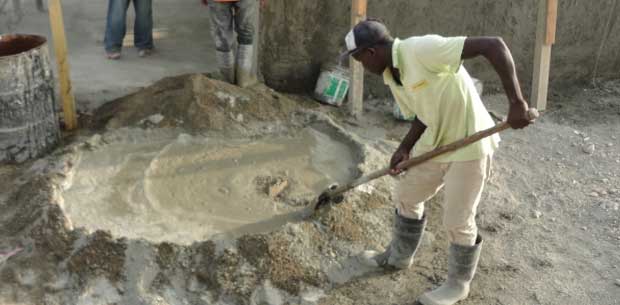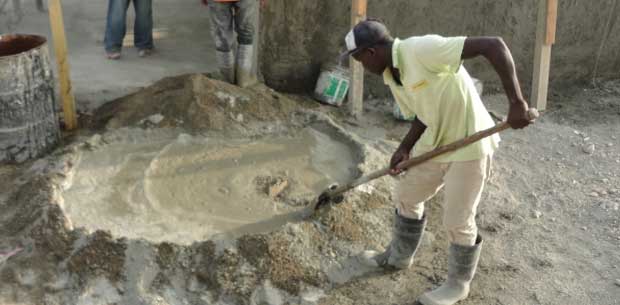In concrete mixing, all components are combined as required, taking into account the mixing proportions of the respective concrete type.
What are the mixing proportions?
When concrete is produced for different purposes, different qualities of the concrete are taken into consideration. The quality of concrete indicates its resistance.
The strength of concrete is achieved through different combinations of cement, water and aggregates (fine and coarse). The most important relationship we consider when categorizing strength classes is the water-cement ratio.
Types of Concrete Mixing Methods
There are basically three methods for mixing concrete
- Manual mixing
- Mechanical mixing (mixing machine)
- Ready-made concrete
Manual mixing
This is also known as hand mixing in construction.
All work is carried out manually and without the use of machines. Mixing and quantification of the required material are carried out according to standard procedures.
This is very common in smaller projects. The construction of one- and two-story buildings is mainly done by hand mixing.


If we follow the correct procedures and ensure that the quantities of each material are correct, there is no need to worry about this method.
However, incorrect practices can lead to problems with concrete strength and durability. Therefore, we must be careful when hand mixing is carried out to ensure the concrete .
Additionally, workers become tired when mixing concrete takes place over a long period of time. This can lead to a loss of concrete consistency.
The following table lists typical mixing proportions for a 50 kg bag of cement.
| Specified mix | Equivalent concrete quality | Fine aggregate | Coarse-grained aggregate | Approximate water content in liters |
| 1:1:2 | C30 | 0.035m3 | 0.07m3 | 20 |
| 1:1,5:3 | C25 | 0.053m3 | 0.105m3 | 22.5 |
| 1:2:4 | C20 | 0.07m3 | 0.14m3 | 25 |
| 1:3:6 | C10 | 0.105m3 | 0.210m3 | 35 |
| 1:4:8 | 0.14m3 | 0.28m3 | 40 |
In practice, with the exception of water, it would be difficult to easily measure quantities using the column.
For this reason, boxes corresponding to the quantities mentioned above are often used.
The internal dimensions of the box are 400x350x250 mm and are 0.035 m 3 .
Therefore, the above table can be written as follows.
| Specified mix | Equivalent concrete quality | Fine aggregate
Boxing |
Coarse-grained aggregate | Approximate water content in liters |
| 1:1:2 | C30 | 1 box | 2 cardboard | 20 |
| 1:1,5:3 | C25 | 1.5 boxes | 3 boxes | 22.5 |
| 1:2:4 | C20 | 2 boxes | 4 boxes | 25 |
| 1:3:6 | C10 | 3 boxes | 6 boxes | 35 |
| 1:4:8 | 4 boxes | 8 boxes | 40 |
When mixing concrete, it often happens that quantity measurements are not made accurately and do not follow the method described above.
As a result, low-quality concrete can be observed. Uneven addition of water to the mix also reduces strength as the water-cement ratio increases.
Mechanical mixing (mixing machine)
Machine mixing is more advanced than hand mixing in terms of the mixing method and ensuring that the mixture always has the same consistency.
However, the amount of material spilled into the container may remain the same if not controlled properly.
A suitable mechanism must be implemented to ensure that the quantities correspond to the composition of the mixture.
For example, the water-cement ratio plays an important role in developing strength. As we add more and more water, the strength of the concrete reduces.
As indicated in the table above, we can use standard containers to measure quantities. Water can also be easily measured and placed in the container. This allows the concrete to be produced with the required strength.


This is a machine that works with the help of a motor. The number of revolutions depends on the concrete to be mixed. This can be easily moved from one construction site to another.
The concrete mix can then be removed and put into place.
Ready-made concrete
Ready-mixed concrete is the most commonly used type of concrete in the construction industry.
The two types of concrete based on the mixing process are used in smaller projects.
Filling ready-mix concrete is a more complicated process associated with modern technology. All measurements are done electronically and with a simple press of a button we can pour the concrete into the truck mix.
Fine aggregates, coarse aggregates, cement, water and other additives are added electronically to the mixing vessel. First, we need to specify the quantities needed based on the composition of the mixture. After that, everything can be done with the push of a button.
The following figure shows the entire process of projecting ready-made concrete.


Although this requires some advance planning, it is the easiest method of making concrete.
The article written as Ready concrete For more information you can contact us.

